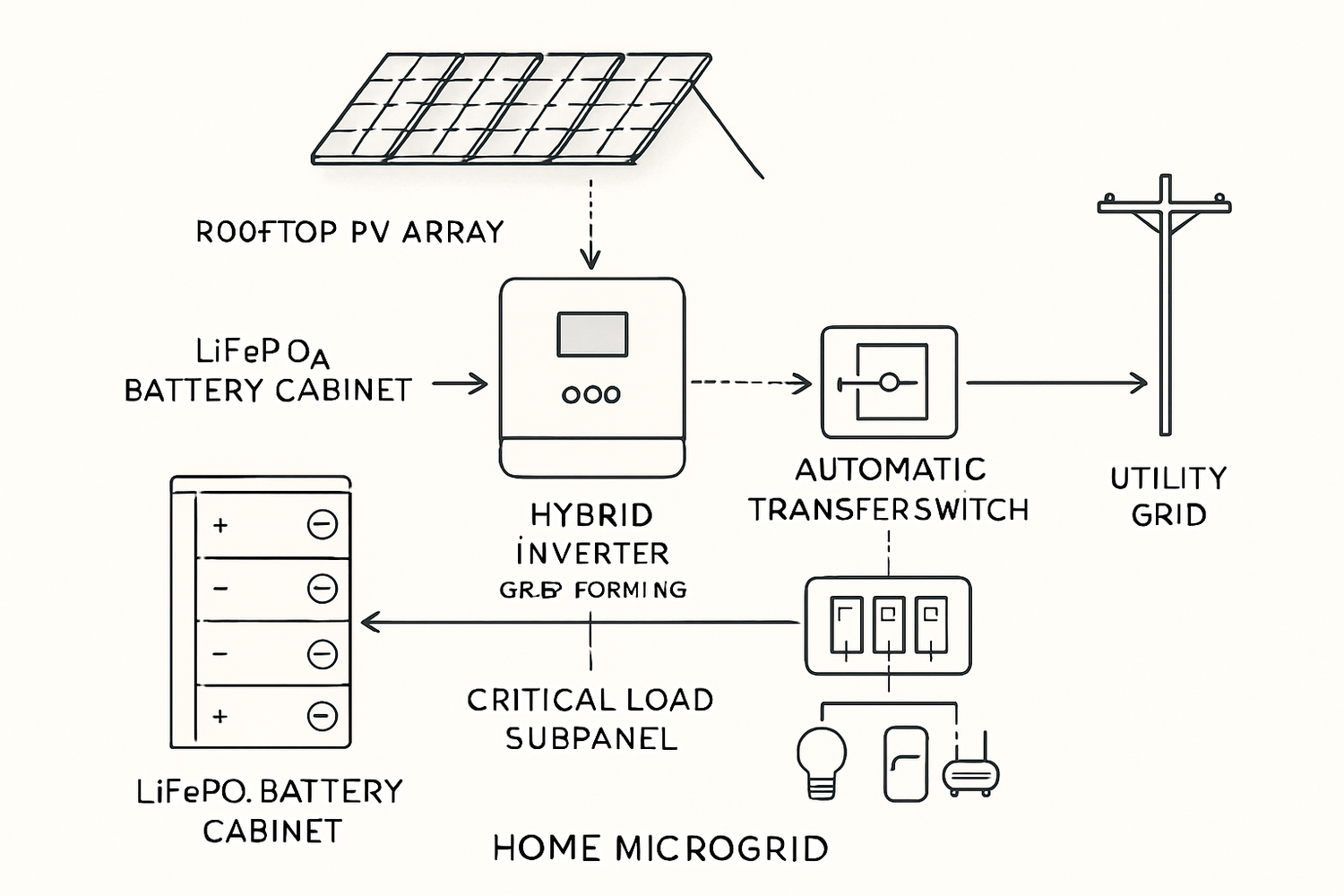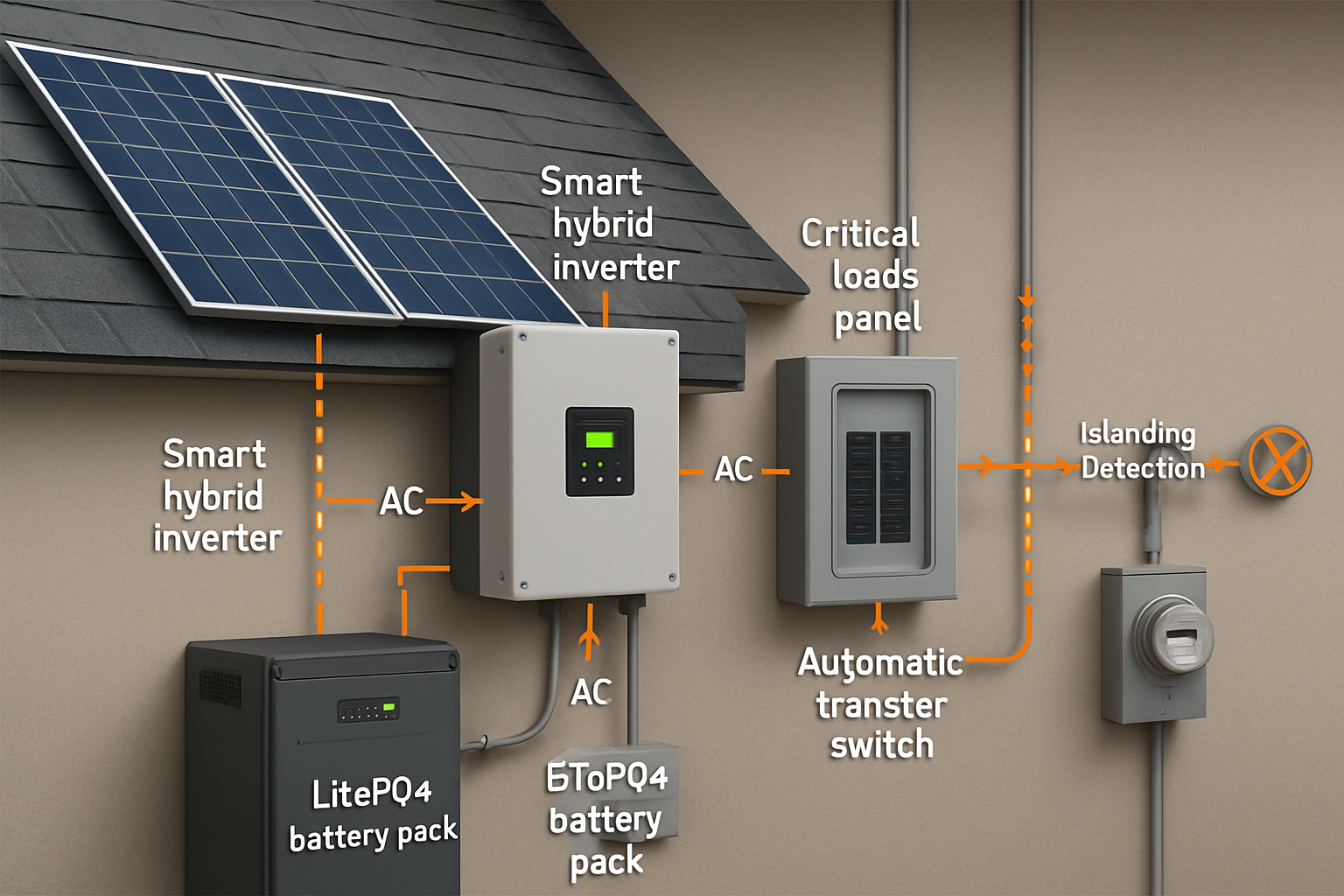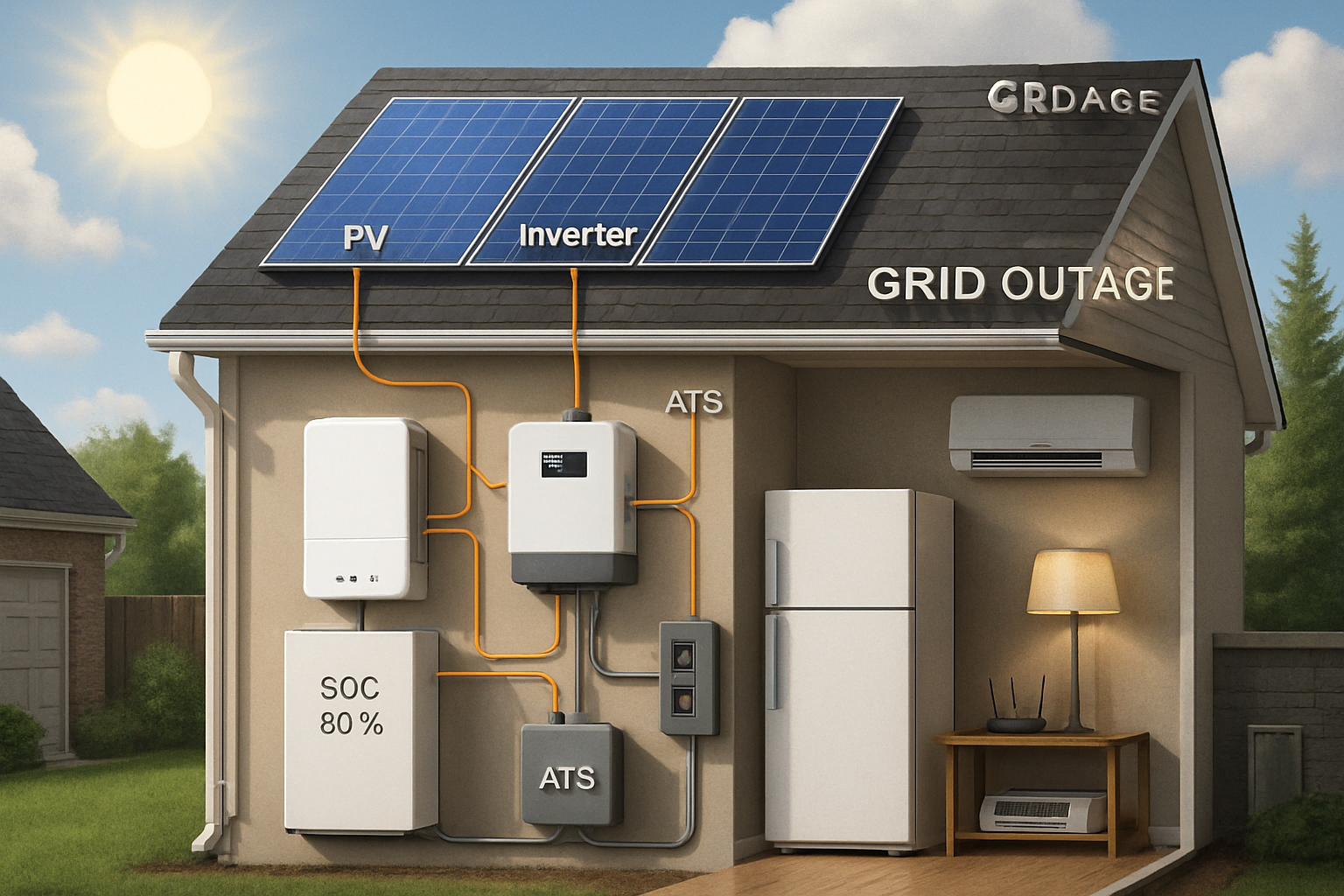Blackouts keep happening. Rooftop solar alone does not keep lights on during an outage. The fix is simple in concept: add storage and the right control gear. This Resilience Blueprint shows how Solar Plus Storage becomes a practical blackout solution, why grid‑tied PV shuts off during solar power outages, and how to size and deploy systems that ride blackouts safely.
Why grid‑tied PV shuts off in blackouts
Anti‑islanding keeps workers safe
Standard grid‑tied inverters must stop exporting power if the utility supply disappears. This anti‑islanding protection prevents back‑feeding lines that crews might be repairing. It’s required by interconnection rules and safety standards. Without a stable voltage and frequency reference, typical PV inverters are designed to cease output.
Ride‑through settings are limited
Modern inverters can support short disturbances. They can “ride‑through” brief voltage or frequency deviations. Yet they still disconnect during a sustained outage. As noted by the International Energy Agency, PV systems may ride‑through small disturbances, but can disconnect if inverters are not programmed to operate during events, a behavior seen more on distributed systems than utility scale assets. See the technical context in Status of Power System Transformation 2018 - Technical Annexes.
IBRs need a grid reference unless they form one
Conventional generators spin and provide inertia. Inverter‑based resources (IBRs) like PV and batteries connect differently and do not supply physical inertia by default. The IEA explains the stability gap clearly, noting that wind and PV are not synchronized to the grid like large rotating machines, which changes system dynamics (Getting Wind and Sun onto the Grid). To operate during outages, a system needs a grid‑forming reference, usually delivered by a battery inverter that can “create” local voltage and frequency for the PV to follow.

The Resilience Blueprint: Solar Plus Storage architecture
Core components
- LiFePO4 battery pack: high safety margin, long cycle life, stable chemistry.
- Hybrid inverter/charger with grid‑forming mode: runs as a local power source during outages and synchronizes to the grid in normal times.
- Automatic transfer switch (ATS) or integrated backup gateway: isolates the home microgrid from utility lines within milliseconds.
- PV array: keeps charging the battery and serving loads in daylight while islanded.
- Critical load subpanel: ensures backup power goes to priority circuits (lights, refrigerator, Wi‑Fi, medical devices, sump pump).
In grid‑connected mode, the inverter follows utility voltage and frequency. During an outage, the ATS opens, the inverter switches to grid‑forming, and the PV follows the inverter’s reference. This allows you to ride blackouts safely and automatically.
Compliance and safety
- Interconnection rules align with IEEE 1547 ride‑through and anti‑islanding requirements.
- Rapid shutdown for rooftop PV follows NEC requirements for firefighter safety.
- Look for UL 9540‑listed energy storage systems with documented thermal management.
Policy work is smoothing the path. The U.S. Department of Energy funded a toolkit to reduce interconnection barriers for storage and solar‑plus‑storage, improving timelines and clarity for utilities and customers (DOE/IREC BATRIES success story).
Right‑size your system to ride blackouts
Estimate daily critical load energy
Start with the devices you must keep on. Multiply power (W) by daily hours to get watt‑hours. Sum to kWh. Add 10–20% buffer for inverter and battery losses.
| Load | Power (W) | Hours/day | Daily energy (Wh) |
|---|---|---|---|
| LED lights (4 rooms) | 60 | 5 | 300 |
| Refrigerator (Energy Star) | 120 (avg) | 24 | 2,880 |
| Wi‑Fi/router + modem | 15 | 24 | 360 |
| Phone/laptop charging | 80 | 2 | 160 |
| Sump pump (intermittent) | 400 | 0.5 | 200 |
| Medical device (if needed) | 50 | 8 | 400 |
| Total | 4,300 Wh ≈ 4.3 kWh |
In this example, a 5–6 kWh LiFePO4 battery can cover a day with modest sunlight. A 10–15 kWh battery gives multi‑day margin, especially during storms.
Check inverter power and surge
- Continuous power: add simultaneous loads. A 3–5 kW inverter suits most homes with a critical subpanel.
- Surge: motors (fridge, pump) can draw 3–6× for a few seconds. Pick an inverter with documented surge headroom.
- PV array size: target daily generation near your backup kWh need. A 3 kW array can produce 9–15 kWh on a sunny day depending on location and season.
Runtime tips
- Prioritize loads. Shift laundry, cooking, and EV charging to grid‑up hours.
- Use daytime solar for high‑draw tasks to avoid draining the battery at night.
- Cold climates: plan for reduced battery capacity at low temperatures; add enclosure heating or place the ESS indoors.
What real outages look like
Outage profiles vary by region and season. Short interruptions are common, and extreme weather can cause multi‑day events. Distributed solar‑plus‑storage can keep critical loads on and reduce the stress of long repairs. DOE notes that small‑scale systems can power critical building loads during grid outages, boosting community resilience (DOE BATRIES).
On grid operations, storage also helps reduce curtailment and improve flexibility. The IEA shows that adding storage and smart EV charging lowers curtailment rates in high‑VRE scenarios (Integrating Solar and Wind). This improves both operational reliability and resilience by shifting solar energy to evening peaks.
Grid‑forming inverters and the resilience gap
Keeping lights on during an outage needs more than energy. You need stable frequency, voltage, and fast controls. Grid‑forming inverters provide that local reference so PV and batteries can run as a self‑contained microgrid. The IEA highlights rapid progress on grid‑forming technologies, while noting that large‑scale operation with many grid‑forming converters still needs further development (Integrating Solar and Wind).
In short, the Resilience Blueprint pairs PV with a battery and a grid‑forming hybrid inverter, plus an ATS and a well‑planned critical load panel. It matches the resilience definition used by power sector planners: anticipate, absorb, adapt, and recover quickly. DOE’s Solar Energy Technologies Office outlines how solar, storage, and flexible loads fit into future power systems with high shares of renewables (U.S. DOE Solar Energy).
Equipment choices that pay off
Battery chemistry
LiFePO4 (LFP) is a strong choice for home and small commercial ESS. It offers a broad safety margin and stable performance. Typical cycle life sits in the thousands of cycles at standard depths of discharge. Thermal stability is higher than many other lithium chemistries. Many customers value this for indoor installations.
Integrated ESS vs. modular approach
- Integrated home ESS: combines LiFePO4 battery, hybrid inverter, and controls. Faster to deploy. Clean enclosure. Good for residential retrofits.
- Modular: separate battery rack, hybrid inverter, and balance‑of‑system parts. Flexible sizing. Often favored in larger homes, farms, or small businesses.
Off‑grid and weak‑grid sites
In remote cabins, farms, or islanded facilities, off‑grid solar solutions provide primary power. Add enough PV and storage to cover several days of loads. A backup generator can charge the battery during extended storms. Combine auto‑start control and fuel‑efficient operation to keep costs steady.
Installation checklist
- Site survey: roof condition, shading, main panel capacity, location for ESS with ventilation and clearance.
- Critical load mapping: identify circuits for the subpanel; label them clearly.
- Interconnection: follow utility rules; confirm ATS placement and current ratings; coordinate inspection steps early.
- Commissioning tests: islanding transfer, load step response, PV re‑engagement after sun/cloud transients, and firmware updates.
- Owner training: app alerts, manual bypass, safe shutdown, and seasonal operating tips.
Regulatory improvements are in motion to make interconnection smoother for storage, as described in DOE’s BATRIES toolkit and process updates (DOE BATRIES).
Cost and value snapshot
Project costs vary by region, labor rates, and roof complexity. Many homes pair a 5–10 kW PV array with a 10–20 kWh LiFePO4 battery. Value comes from outage protection, bill savings under time‑of‑use tariffs, and demand management in small businesses. In areas with rising peak rates, storage shifts midday solar into the evening. The IEA notes that storage is increasingly cost‑effective for PV integration and curtailment reduction in high‑solar grids (Integrating Solar and Wind), a signal that customer‑sited systems deliver benefits at both premises and grid scale. IRENA research also points to storage as a key flexibility asset as renewable shares rise (IRENA).
Real‑life operating tips
- Storm mode: raise the battery reserve setpoint the day a storm approaches so you have more stored energy.
- Quiet backup: unlike generators, batteries are silent and emissions‑free at the point of use. This helps at night and in dense neighborhoods.
- Scalability: start with a core pack and add modules later as needs grow. Many LiFePO4 systems allow parallel expansion.
- Data and alerts: enable remote monitoring. Keep firmware current for improved ride‑through and grid‑forming features as updates roll out.
Putting it all together
A straight grid‑tied PV system shuts off during blackouts for safety. Add a properly sized LiFePO4 battery, a grid‑forming hybrid inverter, an automatic transfer switch, and a critical load subpanel, and you can ride blackouts with confidence. This Resilience Blueprint for Solar Plus Storage turns a solar array into a steady backup power source while also supporting a cleaner grid. Policy and technology are aligning to make interconnection faster and operation smarter, as highlighted by DOE’s interconnection work and IEA research on inverter‑based resources and flexibility (Getting Wind and Sun onto the Grid; Power System Transformation Annexes; Integrating Solar and Wind).
We build lithium batteries, home ESS, off‑grid solar packages, and hybrid inverters designed for reliable, scalable energy. You gain backup power for critical loads, better control over bills, and a practical path to energy independence.





Leave a comment
All comments are moderated before being published.
This site is protected by hCaptcha and the hCaptcha Privacy Policy and Terms of Service apply.